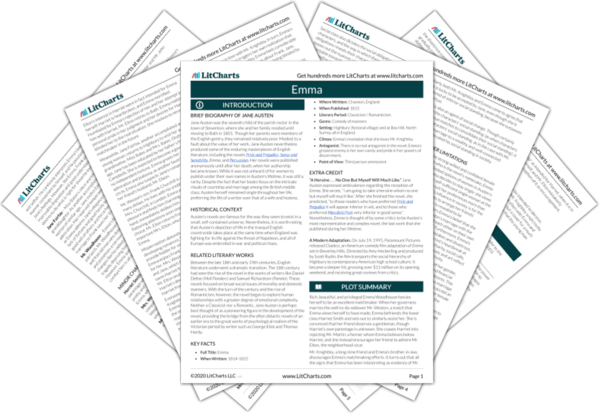Marriage
Emma deals with many visions of what marriage entails. Social acceptability, financial practicality, similar social standing, shared virtues, matching talents, comparable charm and beauty, and similar dispositions are all components that present themselves with different degrees of importance in the marriage calculations of different characters. For women, who were often barred from owning property and faced significant limitations in employment, marriage became particularly critical as both the expected social norm and the often necessary means…
read analysis of MarriageGender Limitations
Despite the strong-willed and confident female protagonist who is the novel’s namesake, Emma reveals the limited options of women in Austen’s era. Early in the novel, Emma decides to stay single: she views her situation as a financially self-sufficient single woman at the top of the social hierarchy to suit her preferences more than being a wife would. Yet Emma’s influence in society is for the most part limited to her attempts to arrange her…
read analysis of Gender Limitations
Misperception
Emma’s initial perceptions of people and her own confidence in her abilities as matchmaker turn out to be very mistaken. Throughout the course of the novel, Emma repeatedly misreads signs of attention and attraction: she believes Mr. Elton to be wooing Harriet, when he is in fact interested only in her; she believes Harriet to be in love with Frank, when she is in fact in love with Mr. Knightley, and…
read analysis of MisperceptionPride and Vanity
Emma is described in the first chapter as an extremely well endowed young woman, who possesses “some of the best blessings of existence”: she is beautiful, intelligent, wealthy, and well bred with a father who loves her dearly. But she also possesses a critical flaw that threatens the success of her intentions to positively interfere with her friends’ lives—her somewhat spoiled nature, and vanity and pride about her abilities and perceptiveness. Because she believes herself…
read analysis of Pride and Vanity












Social Class
Emma, like most of Austen’s novels, is a study in 18th Century English society and the significance of propriety. The rich and “well-bred” control the social situations, issuing and initiating invitations and friendships. Those of low social standing depend upon the charity and initiative of those in the higher class. When violations of this order occur, they are often met with great indignation by those of genteel-breeding, as when Emma takes offense at Mrs.…
read analysis of Social Class